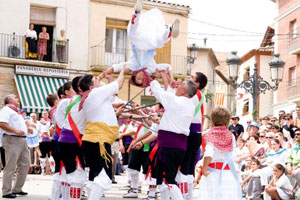Dance of Sariñena

This dance brings together the "mudanzas," a fusion of ancient sword and stick dances, theatrical performances that include dialogues, especially between shepherds and Turks, and staging of the eternal struggle between good and evil through the figures of the angel and the devil.
Because it brings together all these elements, it is considered the most complete in terms of folklore in the Monegros area and a way of preserving and transmitting the ethnological legacy. This is the main reason why this festival is declared "Fiesta de Interés Turístico de Aragón" (Festival of Tourist Interest in Aragon).
It is danced and performed at the patron saint festivals in honor of San Antolín and San Isidro Labrador, which take place on September 2nd and May 15th, respectively.
The dance of Sariñena has 25 mudanzas and 9 pasacalles, each with its corresponding music and dance. The gaita de Boto is used to interpret the music of the mudanzas.
Antonio Beltrán, a professor of Prehistory at the University of Zaragoza and an expert in the customs of the people of Aragon, described it in 1958: "The dance of Sariñena is almost complete: it has shepherd plays, oral reviews, mounts, and offerings; the struggle between good and evil, with the Angel and the Devil; elevation and "decapitation" with an apotheosis in which the "Volantes" participate. There are stick and sword dances, although ribbon and arch dances are missing, perhaps introduced recently. This means that Sariñena preserves one of the most interesting ethnological remains of Aragonese popular life. Preserving it is its duty, and I would even add, not letting the sound of the gaita die out in the future...".






